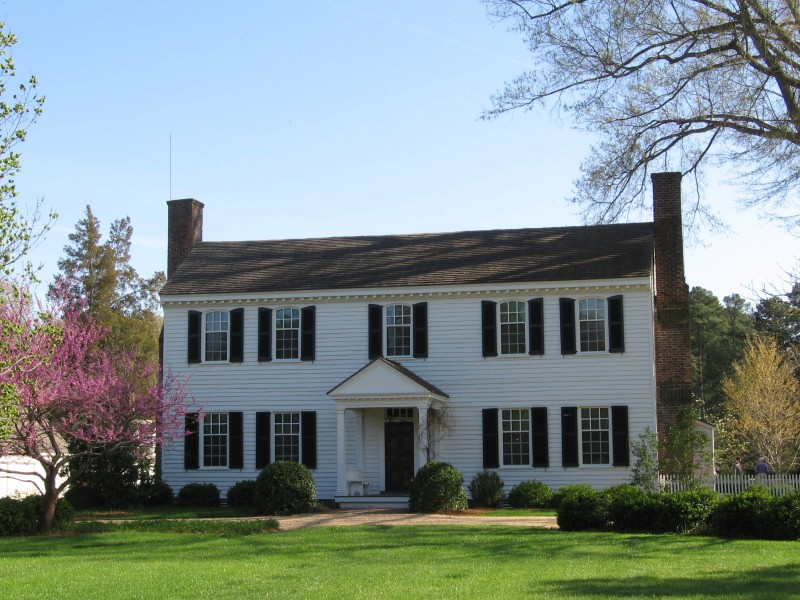Bassett Hall
Introduction
Text-to-speech Audio
Images
2010 photograph of Bassett Hall (Paul Heulskamp)

Backstory and Context
Text-to-speech Audio
The Bassett Hall farmhouse was built from 1753 to 1766 in Williamsburg by a member of the Virginia House of Burgesses, Philip Johnson. The name comes from a nephew of Martha Washington, Burwell Bassett, who bought the property in 1800. The two-story frame dwelling was acquired for Colonial Williamsburg in 1927.
A houseguest for a week during the Civil War was a Union cavalryman named George Armstrong Custer, who was attending the wedding of a friend from West Point, John W. Lea, who had been wounded in the Battle of Williamsburg. Lea was marrying a daughter of the owners of Bassett Hall; he met his fiancée while he was being treated for battle injuries in the house. Custer went on to infamy in the American Indian Wars, dying at the Battle of the Little Bighorn in 1876, or "Custer's Last Stand."
The Reverend Dr. W.A.R. Goodwin, the rector of Bruton Parish Church in Williamsburg, restored the church building in the midst of the former colonial capitol. Goodwin restored another historical building nearby as the church rectory. Goodwin was a member of Phi Beta Kappa, the honorary society founded at the College of William and Mary in the 1700s, where Goodwin was a professor. A new building, Phi Beta Kappa Hall, was being built on campus, just a few blocks from the church. One of the richest men in America, philanthropist John D. Rockefeller, Jr., also was a member of Phi Beta Kappa. Rockefeller visited Williamsburg in 1927 with his family to check on the progress of construction of the hall. While visiting, the Rockefellers were guest of Reverend Goodwin at Bassett Hall. When Mr. Rockefeller returned to Williamsburg for the dedication ceremony of Phi Beta Kappa Hall, Goodwin shared his idea with Rockefeller of rebuilding and restoring the town to its colonial era as a living history museum. Rockefeller cautiously agreed, with a limited initial contribution and a condition of anonymity. That grew into a full-fledged public backing of the undertaking, which took years and many millions more than originally thought.
To keep abreast of the construction, the Rockefellers needed a local home base for their annual visits each spring. The couple's son recounts that Mr. Rockefeller told his wife, Abby Aldrich Rockefeller, that he would buy Bassett Hall as long as she agreed not to take in tourists. Bassett Hall became one of the Rockefellers' homes in 1936. Mrs. Rockefeller thoroughly enjoyed the annual springtime visits to their home in Williamsburg. She would throw an annual Spring Ball where she would dress in colonial attire. Mr. Rockefeller would be seen walking through the historic area, checking ongoing construction. Mrs. Rockefeller died early in 1948, before that year's anticipated spring visit to Williamsburg. Mr. Rockefeller lived until 1960. Bassett Hall first opened to the public in 1980, after being bequeathed by the Rockefellers to Colonial Williamsburg the prior year. The house was closed for restoration in 2000 before reopening in 2002.
The house tour of Bassett Hall is part of the Colonial Williamsburg admissions ticket. Besides the farmhouse, furnished as lived in by the Rockefellers inr the 1930s and 1940s, are several outbuildings: a tea house, smokehouse, kitchen and dairy. Fourteen acres of gardens and woodlands are part of the tour of the property, too. Mrs. Rockefeller's collection of folk art is part of the Colonial Williamsburg Folk Art Museum that bears her name; that museum shares a newly-renovated space with the DeWitt Wallace Decorative Arts Museum elsewhere in Colonial Williamsburg (see the Clio entry for the DeWitt Wallace Museum).
Cite This Entry
Paonessa, Laurie and Clio Admin. "Bassett Hall." Clio: Your Guide to History. February 11, 2020. Accessed April 24, 2025. https://theclio.com/tour/1421/11
Sources
Colonial Williamsburg Foundation. Bassett Hall, Historic Sites and Buildings. 2019. Accessed February 8th 2020. https://www.history.org/almanack/places/hb/hbbass.cfm.
Colonial Williamsburg Foundation. The Rockefellers at Basset Hall. YouTube Video. June 28th 2018. Accessed February 8th 2020. https://www.youtube.com/watch?v=Ptqhdvaqdls.
Virginia Tourism Corporation. Bassett Hall, Virginia is for Lovers, Historic Sites. January 1st 2019. Accessed February 8th 2020. https://www.virginia.org/listings/HistoricSites/BassettHall/.
https://en.wikipedia.org/wiki/Bassett_Hall#/media/File:BassettHall-2010-04-04.jpg

